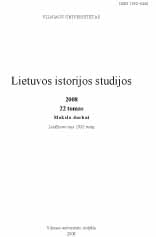STACIONARIOS MAŽMENINĖS PREKYBOSYBOS TINKLO PLĖTRA VILNIUJE IR VILNIAUS APSKRITYE 1861–1904 METAIS
Expansion of a stationary retail trading network in Vilnius and the Vilnius district in 1861–1904
Author(s): Aelita AmbrulevičiūtėSubject(s): History
Published by: Vilniaus Universiteto Leidykla
Summary/Abstract: From local point of view, Vilnius city and its suburb was chosen to analyze stationary trading development process. Vilnius, city which is the center of gubernatorial and general gubernatorial, in 19th century became biggest Russian imperial North-West Land retail trade center, and therefore clearly shows stationary retail trade net development and citizens need changes at Lithuanian and Byelorussia territory, when industrial manufacture extended from 19th century II half till beginning of 20th century. Organization of trade net in Lithuania started at same time as industrialization process, when manufacture order has changed and began intensive trade structure reorganization. At first decades after reforms no trade structure changes was noticed and biggest part of stores were selling “traditional” goods. The network of the daily local enterprise in Lithuania in the middle of the 19th century was thin. Dynamics of the number of the trade in the centres of gubernatorial administration and district, towns, village, countryside was uneven. The biggest pat of the enterprises was founded in Vilnius and in the surroundings of the other big towns. There weren’t growing up of local enterprises in small towns and village, countryside near Vilnius. Weak development of network during the period of the 1860s–1890s was conditioned by couple reasons: in the first decades after reforms the agriculture haven’t been commercialised yet, people’s purchasing power was weak and peasant’s farms just tried to satisfy in-house needs with the minimalistic expenditures. Stationary trade net development intensity we can notice from IX decade as industrial manufacture volumes started to grow and agriculture commercialization is more intensive, some manufacture specialization is more clearly and we can see grow of citizens needs. As per this industrial enterprises pointed out permanent goods realization requirement. To cover these needs more stationary trade enterprises were established: only for period from 1888 till 1904 year number of trade enterprises increasing 4 times. Though number of trade enterprises increasing, but as there was not big number of users in Vilnius city, and in Vilnius suburb settlements was dominating small and average enterprises their spread was determined by small capital domination in trade structure and slow turnover in big enterprises. It shows that home market formation still has not been finished.
Journal: Lietuvos istorijos studijos
- Issue Year: 2008
- Issue No: 22
- Page Range: 74-87
- Page Count: 14
- Language: Lithuanian

